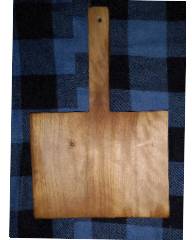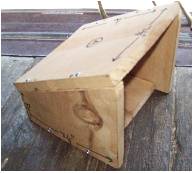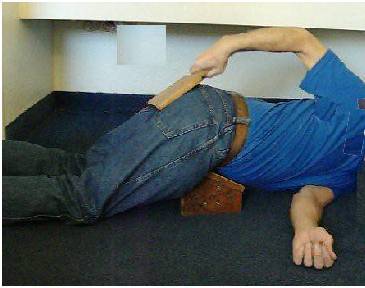use the back browser to return to previous section
Two Pieces of Equipment
Here is how to reinstitute spanking in your personal discipline. First of all, you’re a big boy or girl now, and so mostly you will need an implement. Hand spankings are for before the thirteenth birthday; the hairbrush is for before the eighteenth. After the eighteenth birthday we use a paddle. Not a very big one; it should be neither too light nor too heavy, but of such a size as to bring the adjective “wicked” to mind. Just right.
But the fraternity-style paddle is intended for one person administering punishment to another. Wouldn’t that be a little awkward though, twisting around and whacking yourself that way? Of course it would. That’s why we don’t use the fraternity style in self-discipline; we use the self-applied paddle.
These are good dimensions of a self-applied paddle for normal sized persons: the wood should be hardwood (oak, mahogany, birch). A good thickness is thirteen sixteenths of an inch. The width is 7¾ inches. The length is 6 3/32 inches. From the middle of one of the 7 3/4-inch sides rises a handle an inch and an eighth wide, and 5 5/8 inches long. So the shape is generally that of an oblong breadboard with a handle. If you stood it up on end with the handle stuck up into the air, and sawed it off in the middle, horizontally, it would look like this:

Paddling as punishment is applied usually to the bare bent bottom, and the experience is best if you are resting over something, not simply bent over. Here the object of choice is the Japanese meditation seat. Here are the dimensions of a good one: The wood of the one in the picture below is alder, and 13/16 ths of an inch thick. The back is 7” high; the front is 3 5/16” high; the length of the seat is 8”; the width is 7¼”; the length of the base is 7 ¼”; the width of the base is 6 ½”. The top overhangs the side-supports by about 13/32 “. It looks like this:
Okay, here’s how to get a good one. Place yourself behind the meditation seat so that the high side is toward you. Pull down your pants at least halfway down your thighs, and get over the seat so that your bottom is conveniently placed, and positioned so that it cannot squirm out of the way. If you are male, you will find there is plenty of room for the male equipment in the hollow frame of the seat.
The actual punishment is applied without pants or underwear.
Punishment Units
A spanking is defined as the amount of smacking which brings the behind to the punishment point. That’s where you start to say, “Yes sir or ma’am.” Because you really don’t want any more. When the rear end has been brought to that point, then punishment with the paddle can be very easily applied, according to how bad one has been. It is good to spank to the punishment point
periodically (every 2 to 6 weeks -- you will find your own interval), if only for “general purposes”, to keep you in the right spirit of the discipline. If you adopt this way, you'll probably find that you shouldn't go more than six weeks without one. The more you go without it, the more you are grouped with other people who do not get it, and they're not as good an influence.
In paddle-spanking, one swat on one day often does not equate to the same swat on another day. The flesh in question is like the surface of the ocean; its conditions can vary greatly from day to day. The same whack can be barely felt on one day, and really hurt on another.
In our self-applied ways of discipline, therefor, we use the punishment unit, rather than the whack, as the basic factor. (A punishment unit is defined as five of them bringing you to the punishment point.) To determine a unit, you spank it until, by subjective judgement, as accurate as you can sincerely be, you can say, on your honor, “There. That’s one unit.” Then you continue until you can truthfully say, “There. That’s two units.”
The number of units is generally predetermined, either by a code, or by your self-parenting reaction to the behavior you are punishing.
Technique
Assuming you are right-handed, rest the back part of the left upper arm from the shoulder to the elbow on the floor, twist around slightly and grip the self-applied paddle with the right hand. You can grasp the back of the meditation seat with your left hand. Place the paddle on the bottom, right where the spank will land. Now raise the paddle in the air and give the buttocks an arm-swing, wrist-action smack!, right on the sweet spot. Then give it another. Around five units should bring you to the punishment point, but this is subjective. That it is actually at that point should be a matter of honor. So also with each punishment unit. There should never be more than seven units in total. Remember that the paddle does more damage than you think -- you will become aware of that later in the day and week. One of the ways that spanking discipline works is that we remember it when we sit down. There is a natural tendency to repress punishment, and these constant reminders are really very corrective.
Growing up is not the end of getting it -- it is the end of that peculiar institution of childhood called “getting away with.” Discipline is such a universal need that the pun “kneed” is probably intentional. There is much pressure upon older children to become independent, and this is indeed why they are disciplined less and less as they get older and older. But not being dependent on the parent is often assumed to include not being dependent upon discipline, and that can be a fatal error. In order to not be a baby any more, they’re throwing out the b’thwatter with the baby.
The desire to be a good person is there in everyone, and often the lack of punitive discipline is the only reason why the state of goodness is not realized. That we can be good without it is basically delusional. Moreover, the subconscious mind is a creature of reason, and will avoid punished behaviors because there is a good reason to.
Punishment is not best thought of as justice or retribution. The best way to look at it is from the standpoint of behavior modification science: noxious stimuli paired with unwanted behaviors, for the purpose of bringing about subconscious and unconscious aversion to those behaviors, over time. It is one of the basic ways by which behavior is controlled, whether the control is by self or other. When we punish we are trying to induce a degree of pause for consideration when that person is tempted to again commit the transgression. It is the degree appropriate for that person, in that state of moral growth, with that history of behavior, and “punished enough” consists in that degree having been induced.
There are important differences between this discipline and parenting. For one thing, because you yourself are the discipliner as well as the disciplined, it is omniscient. There is no longer any such thing as getting away with something. For another, and this is very important, the discipline can be applied not only to outward behavior, but also to the inner, unseen behavior of the mind.
space line



